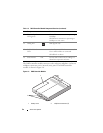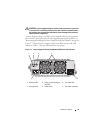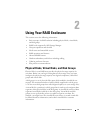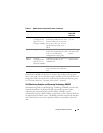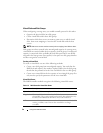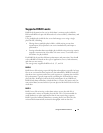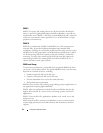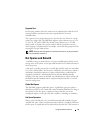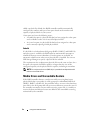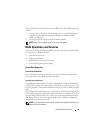
30 Using Your RAID Enclosure
Virtual Disks and Disk Groups
When configuring a storage array, you would normally proceed in this order:
• Organize the physical disks into disk groups.
• Create virtual disks within these disk groups.
• Determine which host servers you want to grant access to which virtual
disks, then create mappings to associate the virtual disks with the host
servers.
NOTE: Host server access must be created prior to mapping virtual disks to them.
Disk groups are always created in the unconfigured capacity of a storage array;
virtual disks are created within the free capacity of a disk group. Unconfigured
capacity is comprised of the available physical disk space that is not already
assigned in the storage array. Free capacity is the space in a disk group that has
not been assigned to a virtual disk.
Creating a Virtual Disk
To create a virtual disk, use one of the following methods:
• Create a new disk group from unconfigured capacity. You can define the
RAID level and capacity (the number of physical disks) for the disk group,
then define the parameters for the first virtual disk in the new disk group.
• Create a new virtual disk in the free capacity of an existing disk group. You
only need to specify the parameters for the new virtual disk.
Virtual Disk States
The RAID controller module recognizes the following virtual disk states.
Table 2-2. RAID Controller Virtual Disk States
State Description
Optimal The virtual disk contains physical disks that are all online.
Degraded The virtual disk with a redundant RAID level contains an inaccessible
physical disk. The system can still work properly, but performance may
be affected and additional disk failures may result in data loss.
Offline A virtual disk with one or more member disks in an inaccessible (failed,
missing, or offline) state. Data on the virtual disk is no longer
accessible.



